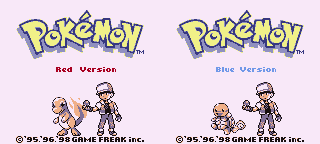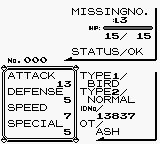Pokémon Rojo y Azul
| Pokémon Red Version and Blue Version |
|---|
|
Also known as: Pocket Monsters: Red & Green (JP), Pocket Monsters: Blue (JP)
|
| Pokémon Rojo y Azul |
|---|
|
Also known as: Pocket Monsters: Red & Green (JP), Pocket Monsters: Blue (JP)
|
Pokémon Rojo y Azul, originalmente lanzado en Japón comoPocket Monsters: Red y Green y mas tarde como Pocket Monsters: Blue, son juegos del original Pokémon que pegan a muchos niños a sus Game Boys, ya que comenzó su búsqueda para convertirse en el campeón de Pokémon.
¡Hazte con todos!
| To do: ¿No deberia fusionarse esta página conYellow, considerando que todos son basicamente el mismo juego? |
Sub-Páginas
| Errores de traducción Errores en los textos cuando fueron traducidos de un lenguaje a otro. |
| Diferencias de versiones Las diferencias en las versiones, así como los cambios de localización. |
| Game Genie Code | Offsets to Patch |
|---|---|
| 132-2FB-F7D | 0x822F to 13 |
| 692-30B-7F7 | 0x8230 to 69 |
| CF2-32B-917 | 0x8232 to CF |
| 692-33B-4CB | 0x8233 to 69 |
The full two-channel song was later found in the English source code leak, there known as Koukan, which translated to "Trade". Based on the commented out headers and the channel data itself, the track's channels were meant to be split between both Game Boys with one channel playing on one Game Boy and the other playing on the other. A similar behavior was ultimately used in Pokémon Ruby and Sapphire for multiplayer Pokémon Contests. Additionally, this song was also found in the Pokémon Gold and Silver source code leak as EFFDATA/M_TRADE.DAT, which plays the source version.
También de la nota es el nombre teprano de Nidoking que, antes que el final ニドキング (Nidokingu), es マイコー♂ (Maiko♂).
Unused Cry Base
An unused cry base. This is not referenced by pointer table, therefore there is no ID associated with this cry base. This would later find its way into Pokémon Crystal, where it's still unused and unreferenced.
Unused Type
Found in both Generation I and Generation II games is an unused type known as "Bird". This type, which lacks any weaknesses or resistances, is only assigned to MissingNo. and is believed to have been either an earlier or alternate version of the Flying type.
Unused Celadon Warp
An unused warp to the fifth floor of the Celadon Department Store (map 136) exists in Celadon City, located on the building to the right of the Prize Corner where a door would normally be found. Exit location data also exists for the map, with the exit point index number being 08.
| ID | Grito |
|---|---|
| 0x43 | |
| 0x4F | |
| 0x51 | |
| 0x5E | |
| 0x5F | |
| 0x7F | |
| 0x89 | |
| 0xB5 |
You can create a door to access the warp with the GameShark code 017C72C8. You can appear where the warp is by using the GameShark codes 0108B5D3 0108B1D3, entering a certain map in Celadon City (such as the Pokémon Center) and exiting.
Unused Scripted SFX
There exists three unused scripted events in which a sound effect would have been played using a text command. For example, the Dewgong cry would have played if the player interacted with an "NPC" version of this Pokémon. However, in that specific case it never gets used as no Dewgong exists in that form in the final games, with only a member of the Pokémon Fan Club owning a Seel.
TX_SOUND_POKEDEX_RATING, SFX_POKEDEX_RATING TX_SOUND_GET_ITEM_1_DUPLICATE, SFX_GET_ITEM_1 TX_SOUND_CRY_DEWGONG, DEWGONG
- Pages missing developer references
- Games developed by Game Freak
- Pages missing publisher references
- Games published by Nintendo
- Pages missing date references
- Games with unused areas
- Games with unused code
- Games with hidden development-related text
- Games with unused graphics
- Games with unused items
- Games with unused music
- Games with unused sounds
- Games with unused text
- Games with debugging functions
- Games with regional differences
- Games with revisional differences
- Games with hidden developer messages
- To do
- Pokémon series
Cleanup > Pages missing date references
Cleanup > Pages missing developer references
Cleanup > Pages missing publisher references
Cleanup > To do
Games > Games by content > Games with debugging functions
Games > Games by content > Games with hidden developer messages
Games > Games by content > Games with hidden development-related text
Games > Games by content > Games with regional differences
Games > Games by content > Games with revisional differences
Games > Games by content > Games with unused areas
Games > Games by content > Games with unused code
Games > Games by content > Games with unused graphics
Games > Games by content > Games with unused items
Games > Games by content > Games with unused music
Games > Games by content > Games with unused sounds
Games > Games by content > Games with unused text
Games > Games by developer > Games developed by Game Freak
Games > Games by publisher > Games published by Nintendo
Games > Games by series > Pokémon series



